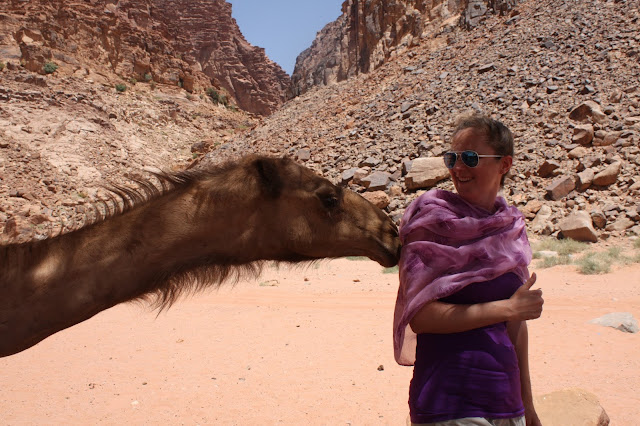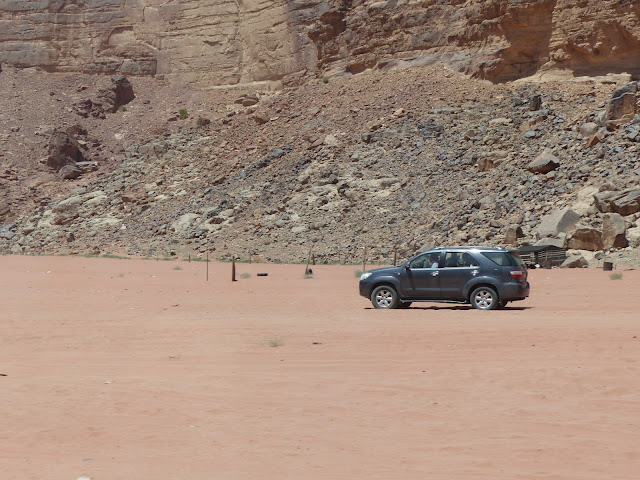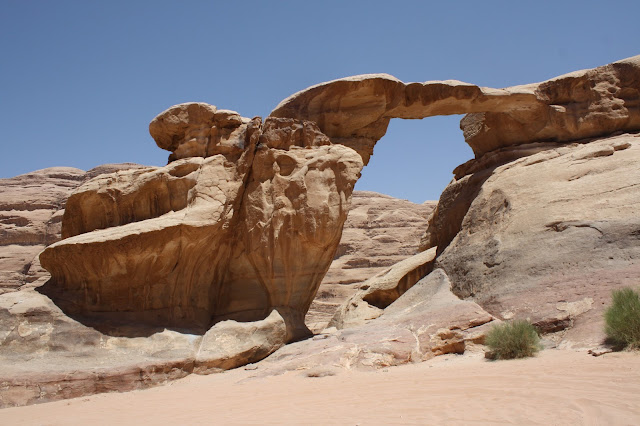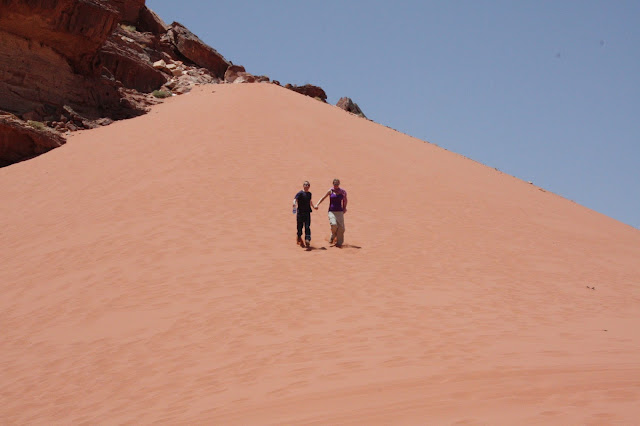A Lesser-Known Heritage Site of Jordan
 |
| A camel we found and petted while grazing decided he was not done with me as I started to walk back to our SUV. |
Any westerner who has heard of Wadi Rum probably recognizes its name from the 1961 movie
Lawrence of Arabia. T. E. Lawrence was a British Colonel in World War I who successfully united the constantly waring Arab tribes against their oppressors the Ottoman Empire. Lawrence wrote an autobiography
Seven Pillars of Wisdom (named after a rock formation in Wadi Rum) which was the inspiration for the subsequent movie.
 |
| One of the 4x4 SUVs we used to get around the untamed Wadi Rum. |
I watched
Lawrence of Arabia in preparation for visiting Wadi Rum, where much of the movie was filmed. I must say, I usually hate movies of this era. There is no greater torture than the
Sound of Music, but I really liked
Lawrence of Arabia, all four hours of it. One of my favorite scenes from the movie is when Lawrence convinces a Bedouin Chieftain to invite his group of Bedouin warriors from an enemy tribe to dinner instead of trying to kill them. The chieftain proclaims "Tonight we dine in Wadi Rum!" whilst raising his sword towards the sky. The gusto of his statement really drives home how important this valley is culturally to these people.
 |
| The rock formation of "pillars" which gave T.E. Lawrence's biography its name. |
In reality Lawrence only spent a couple of days in Wadi Rum throughout his entire campaign. He spent way more time in the port city of Aqaba, but after the movie was released and tourism to Wadi Rum increased, the locals renamed much of the features of northern Wadi Rum after Lawrence. It's a little sad to me as this downplays the cultural importance to the people that actually live there.
 |
| Munching on a delicious lunch made by our guides in the shade of a sandstone cliff. |
The Bedouin of that time, and some still do, live in tents that can be moved in search of better pasture. So very few permanent settlements exist in Wadi Rum. Only houses built by Queen Noir for the Bedouin people or small semi permanent camp/hotels exist in the valley. Most of the valley is just open red sand with a sparse amount of trees and grasses. If there is a place to go to get away from crowds, Wadi Rum is it. Since no roads exist, the only way to get around Wadi Rum in a motorized vehicle is in a 4x4 truck or SUV.
 |
| The sandstone arch we would soon climb. |
Our largish group booked two guides each with a 4x4 air conditioned SUV to give us a one day tour of the valley. Since there is little infrastructure, our tour was comprised of bouncing around in the sand as the SUVs trundled along (probably my favorite part of the whole Wadi Rum experience) and stopping every now and then for a short hike up a rock formation or sandstone arch. After a long morning over-heating (it was summer in the desert) we stopped for lunch in the shade of a cliff, where our guides broke out a little coal burning grill and made lunch from scratch. The lunch was pretty outstanding, consisting of two freshly made salads, pita, hummus, grilled peppers and onions, and chicken (which I did not eat, but was told was tasty).
 |
| Climbing the sand dunes is hard work, running down them only fun. |
While my SUV group thoroughly enjoyed our time in Wadi Rum, with a very talkative and informative guide with great cooking skills, other friends who went to Wadi Rum with the same tour company but different guides did not have such an awesome experience. Either they wound up bouncing around the back of a pick up truck or eating hotdogs and canned tuna for lunch, bleh! I think since our group was a bit larger, the tour company paid more for better guides, but I cannot say that with 100% certainty. For sure the quality of a tour in Wadi Rum varies substantially on the quality of the guide, which I suggest visitors make a top priority.
 |
| Walking back to Israel from Jordan in the no man's land between Jordanian and Israeli security and passport control. |
We ended our tour of Wadi Rum by making our way back to Eilat in
Israel. Our guide drove us to the border crossing, where we made the trek through the empty gap of land visitors must walk across to cross the border between each country's passport control and security screening. Getting to Wadi Rum and
Petra is easiest in this part of
Jordan. A special visa which does not cost any money or application is issued in Aqaba, where visors can enter through the port from a cruise ship or from walking across the border from
Israel. The visa is good for 30 days and the only requirements are that the person does not leave the designated area (including Aqaba,
Petra, and Wadi Rum, actually quite a large area) and that the leave the same way they came (on a cruise ship or walking to
Israel).


No comments:
Post a Comment